
pre-1900 : 1900 and later

pre-1900 :
1900 and
later
| Date of Publication |
Title of resource |
Author/s |
S |
| 1905 | With Sword and Statute | Major D B Hook | 9 |
| 1912 | Cape of Adventure | Ian D Colvin | 4 |
| 1914 | The Diary of Adam Tas | Adam Tas | 5 |
| 1916 | Pioneers in South Africa | Sir Harry Johnstone | 5 |
| 1918 | Christina Forsyth of Fingoland, the story of the loneliest woman in Africa | W P Livingstone | 3 |
| 1918 | The Transkei | Miss M H Mason | 9 |
| 1926 | The Fellowship of the Veld | Godfrey Callaway | 4 |
| 1931 | The Grand Old Days of the Diamond Fields | George Beet | 5 |
| 1936 | More Annal of Natal | A F Hattersley M.A. | 4 |
| 1937 | Galloping Jack | Napier Devitt FRSA | 10 |
| 1937 | Zulu Journey | Carel Birkby | 4 |
| 1937 | The Romance of a South African village | M T R Smit | 7 |
| 1938 | Later Annals of Natal | A F Hattersley M.A. |
9 |
| 1946 | Pioneers of Underberg | Peter McKenzie | 9 |
| 1953 | Travels in the interior of South Africa (Signed by I Schapera) | William J Burchell | 9 |
| 1954 | A talk on Old Umzimkulu | Miss Freda Paynter | 9 |
| 1955 | Lightest Africa | F Spencer Chapman | 2 |
| 1960 | Hancock's Drift | F W Powell | 10 |
| 1962 | Stanford's Reminiscences | J W MacQuarrie | 3 |
| 1967 | Travels in the interior of South Africa (Limited Edition reprint of 1822/24 Volumes) | William J Burchell | 6 |
| 1968 | Woodcut Vignettes from "Travel in the interior of South Africa" | William J Burchell | 1 |
| 1969 | Gleanings in Africa (reprint of 1806 edition) | Various letters |
8 |
| 1984 | On the high flats of Natal | Valerie Woodley | 9 |
| 1985 | No Man's Land - Griqualand | Ken Strachan | 10 |
| 1986 | A Hunter's Life in South Africa (Reprint of 1850 First Edition) | R Gordon Cumming | 3 |
| 1986 | From Ox-Wagon to Motor Car in East Griqualand | Robert Percy Larkan | 10 |
| 1992 | The Touwfontein Letters - William Porter | Karel Schoeman | 3 |
| 2000 | David's Story | Zoe Wicomb | 1 |
| 2006 | "Old King Cole" James Cole of Riverside | Milner Snell | 8 |
| 2007 | A small river in a great valley, a journey through old Umzimkulu | Milner Snell | 8 |
*(S Rating) Scarcity Rating (includes
scarcity, relevance and content) - with 10 being the most desirable and 1
easiest to acquire. Those highlighted in the deeper shades of red are highly
sought after works.

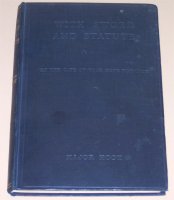 With Sword and
Statute - Major D B Hook
1905
With Sword and
Statute - Major D B Hook
1905
 Recollections of
a mounted officer on the Cape of Good Hope frontier, who came to South Africa
as a young boy. He served in most frontier wars and expeditions and was acting
chief magistrate in Griqualand East at various times and resident magistrate
in Herschel during the Boer war. 147 pages. Illus. with black/white photos
and line drawings. The book was once owned by the wife of Charles Anthony
Junior.
Recollections of
a mounted officer on the Cape of Good Hope frontier, who came to South Africa
as a young boy. He served in most frontier wars and expeditions and was acting
chief magistrate in Griqualand East at various times and resident magistrate
in Herschel during the Boer war. 147 pages. Illus. with black/white photos
and line drawings. The book was once owned by the wife of Charles Anthony
Junior.
Extracts: In the village of Umzimkulu I was warned to ingratiate myself with the ex-Griqua magistrate (Donald Strachan), who had also been a justice under British rule, and who was also a native chief in fact. I found that ex-justice and chief a charming Scotchman, full of fun and devilry. He could a tale unfold of border history if taken at the tide. He was a chief in right by native installation, and could speak the langauages. Since then he became a legislator in the Upper House of the Cape Parliament....
The possessions of one man alone "Jim Cole" quite a principality; milking sixty cows; thoroughbred horses, imported mixed with kaffir stock, miles and miles of farms along a shining river etc. But the Prince of Denmark was "George" (G C Brisley), of tracts in red traced upon a map, who dwelt up at the Pines. In easy days he would engineer and make a road; a stone in the way, he would bury it in the track. Charming eloquence for ever as his friend passed by. At last the rock died, and disappeared from view, like padda under ground. The tongue of George no more waxed eloquent, even to his best of friends; the soul of conversation dead.
More on Major Hook's visit to East Griqualand with Cecil Rhodes at this link.
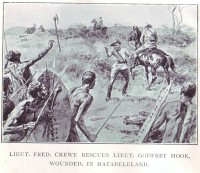 |
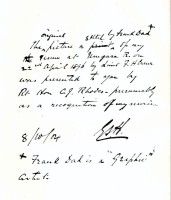 |
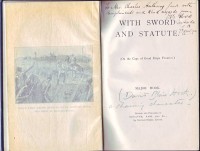 |
The rescue of Lieut G Hook by |
and Hook's note on this |
Frontispiece signed by Major Hook |
Transcript scan above: |
||
Major David Blair Hook |
Transcript above: |
A very rare photo of Sir Walter Currie |
This very rare book (unsigned) sells for over US$1,000
The copy held by the Balson Holdings Family Trust is in excellent condition and has been inscribed by the author and his brother Lieut G Hook and includes a lengthy letter and small photo from his wife to a family friend, Mrs Charles Anthony Junior, the recipient of the book.
Critical comment on this work:A fascinating book which looks into the life and times of the people in East Griqualand in the 1800s. |
 Cape
of Adventure - Ian D Colvin (1912)
Cape
of Adventure - Ian D Colvin (1912)
This 460 page book is the English translation of reports by several early settlers on their visit to South Africa.
The reports include John de Barros (1497) and many other authors whose books already form part of this collection.
The value in this book is the graphic reports on the early communication made between the sailors and the Hottentots of South Africa.
There are numerous illustrations throughout the book.
The Balson Holdings Family Trust has a hard covered copy in very good condition.
Critical comment on this work:Valuable research on the early interaction and meetings between the Hottentots and natives with passing sailors as well as people shipwrecked in South Africa |
 The
Diary of Adam Tas - Adam Tas 1705-06 (1914 - English Reprint)
The
Diary of Adam Tas - Adam Tas 1705-06 (1914 - English Reprint)
This 360 page book carries an English and Afrikaans translation of the original 1705-06 diary of Adam Tas.
Adam Tas was one of four Dutch burgers who took on the then Governor of the Cape, William Adrian van der Stel.
They were arrested and housed in the Castle for over a year for their efforts in exposing the Governors corruption when it came to building an empire for himself.
This diary was instrumental in van der Stel's demise after he was recalled to Batavia and was published in Dutch in the early 1700s.
The Balson Holdings Family Trust has a hard covered copy in very good condition.
Critical comment on this work:Fascinating work, which reveals just how badly the Hottentots were treated by settlers. |
 Pioneers in South Africa- Sir Harry Johnstone
Pioneers in South Africa- Sir Harry Johnstone
This 316 page hardcovered book gives a populist colonial
view on the early history of South Africa.
The important role the Griqua
played is totally overlooked to the point of hardly rating a mention while
the development of the Kimberley diamond mines is given great
importance.
There are some great images (some below) and maps throughout
the book - which is scarce.
The Divett Place
referred to below is in
the Adelaide, South Australian region - where this book was purchased.
The Balson Holdings Family Trust has a hard covered copy in very good condition.
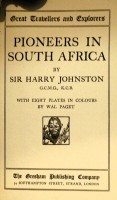 |
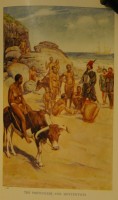 |
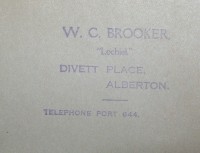 |
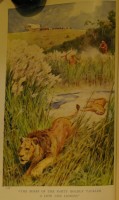 |
Critical comment on this work:Lacking in historical accuracy but easy reading and generally correct. |
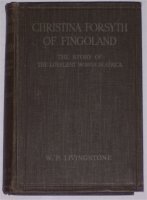 Christina Forsyth of Fingoland, the story of the loneliest
woman in Africa (1918)
Christina Forsyth of Fingoland, the story of the loneliest
woman in Africa (1918)
Christina Forsyth lived alone for thirty years in a remote mission station in Fingoland, near Nomansland.
The book gives valuable insight into the hurdles faced by the Griquas in the 1800s.
The book is easily available - many copies being offered for sale on the Internet.
The copy held by the Balson Holdings Family Trust is in very good condition.
Critical comment on this work:A fascinating book which looks into the life and times of the people in East Griqualand in the 1800s. |

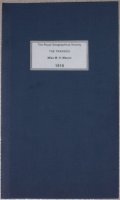 The Transkei - Miss M H Mason (1918)
The Transkei - Miss M H Mason (1918)
Miss Mason travelled to the Transkei (East Griqualand) in the early 1900s. In this 15 page article reproduced from her speech to the Royal Geographic Society on 22nd April 1918 she discusses her experiences and how she found the land at that time.
There were still buck to be found but much of the land had been cleared and fenced for grazing and white farmers now dominated in the Griquas old homeland.
The copy held by the Balson Holdings Family Trust is in very good condition.
Critical comment on this work:A fascinating book which looks into the life and times of the people in East Griqualand in the early 1900s. |
 The Fellowship of the Veld - Godfrey Callaway
(1926)
The Fellowship of the Veld - Godfrey Callaway
(1926)
This interesting missionary book was witten by Father Calloway who records his experiences in Natal, Nomansland and Zululand.
Although he followed many years after Rev W Dower his comments and observations are of great value when understanding the plight of the indigenous people of South Africa.
The book can be quite cheaply and easily acquired on the Internet.
The Balson Holdings Family Trust has a copy in very good condition.
Critical comment on this work:A hands on observation by a priest who was well respected in his time |
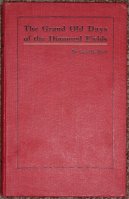 The
Grand Old Days of the Diamond Fields -
The
Grand Old Days of the Diamond Fields - This 192 page hard covered book by George Beet traces the history of the diamond fields in Griqualand West. Beet's wife was a direct descendant of the 1820 settlers and her father one of the first diamond diggers.
The book just touches on the Griquas in a chapter headed "Rival Complainants". Like many other books of this period the Griquas claims are presented as being unfounded - despite a mountain of evidence supporting their land claims.
The book has over fifty period photos showing various diamond mines, buildings, people etc.., including the big hole of Kimberley, in its very early stages of mining.
An interesting read
The Balson Holdings Family Trust has a copy in very good condition.
Critical comment on this work:The chapter on the Griquas and their claim is poorly researched and misses key issues. |
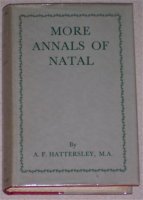 More Annals of Natal - A F Hattersley M.A. (1936)
More Annals of Natal - A F Hattersley M.A. (1936)
This book is particularly valuable in its description and first hand account of settlers who left England and came to Natal under the Byrne land scheme.
The book exposes the deception under which Byrne set up and marketed the scheme. The low cost (ten pounds) and promises of free land sounded to good to be true and they were - one of the settlers Cato, who Cato Ridge is named after, set up an auction house some distance from D'Urban - here the belongings of settlers who had been left destitute by the scheme were sold off.
The Strachan family came to Natal under the Byrne scheme, and the two young boys, Donald and Thomas, lost their (Mary) mother on the treacherous 100 day voyage from England to Natal and their father (Robert) not long after they landed in D'Urban.
A sad but interesting book which runs to over 250 pages.
The book can be quite cheaply and easily acquired on the Internet.
The Balson Holdings Family Trust has a first edition hard copy in very good condition.
Critical comment on this work:An interesting compilation of letters, comments and papers by early settlers - a bit limited in its overall view of Natal |

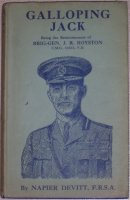 Galloping Jack - Napier Devitt (1937)
Galloping Jack - Napier Devitt (1937)
This 125 page hard covered book by Napier Devitt is about that extraordinary man Brigadier General John R Royston who in the 1880s owned the St Faiths store on the banks of the Umzimkulu River, a remote outpost situated between the town of Umzimkulu and the Indian Ocean. Devitt also wrote the rare propaganda booklet The Concentration Camps in South Africa in 1941.
The book covers in some detail the remarkable military history of John Royston who was known as "Galloping Jack" because of his valour on horseback which included riding six horses to their death (through being shot by the enemy) while encouraging his troops at the battle of Romani during the Palestinian Campaign during the first world war. "Galloping Jack" would mount a horse then ride out into the battlefield in full view of the enemy and in range of their guns while encouraging his troops to fight on.
Napier Devitt gathered the information from direct interviews with John Royston.
Our interest in the book is the old surviving copy of Royston's St Faith's
store coinage... a sixpence which can be seen in the image below. More on
this unique
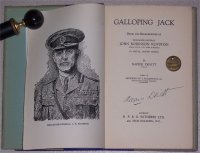 sixpence owned by the Balson Holdings Family Trust
can be seen at this link.
sixpence owned by the Balson Holdings Family Trust
can be seen at this link.
Here is an extract from Chapter Four (pp 37):
At that time Royston's headquarters were at his farm in the Ixopo district, "St Faith", and from here he set forward some of his trading ventures. Here, young as he was, he was consulted by the headman and that, and not infrequently visited by Government authorities who seemed to place some store by his influence among the tribes of north-west Natal.
The Balson Holdings Family Trust has two copies in excellent condition including a copy signed by Napier Devitt (above right).
Critical comment on this work:An excellent and very rare book that just cannot be found today - even on the Internet |
 Zulu Journey - Carel Birkby (1937)
Zulu Journey - Carel Birkby (1937)
This 300 page book covers the personal experience of Carel Birkby in East Griqualand and Natal.
Birkby is so enamoured with the legend of "Old King Cole" (Jim Cole of "Ujim trade token coin fame") that he dedicates an entire Chapter (XIV) headed "Old King Cole" running eight pages to an interview that he had with the old man (he was 96) at his Riverside home.
His comments about "Ujim's" coins can be seen at this link. Interestingly he says that these trade tokens, like their forerunner, the trade tokens of Strachan and Co, were used as currency through large parts of East Griqualand.
The book can be quite cheaply and easily acquired on the Internet.
The Balson Holdings Family Trust has a first edition hard copy in very good condition.
Critical comment on this work:For a collector of early South African trade tokens this is a valuable work - Birkby's writing style is easy to read and entertaining. A very nice book. Birkby reveals why Dower's book "The Early Annals of Kokstad and East Griqualand" is so rare today. |

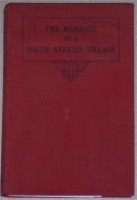 This
169 page book on the early days of the village of Ugie includes a map. The
village cuddles beautifully at the foot of the south-eastern slopes of the
Drakensberg Mountains in East Griqualand, South Africa.
This
169 page book on the early days of the village of Ugie includes a map. The
village cuddles beautifully at the foot of the south-eastern slopes of the
Drakensberg Mountains in East Griqualand, South Africa.
Nature has been bountiful with the country surrounding the little township. Close to the village are hills rising higher and higher until they reach the slopes of Prentjiesberg, whose peaks stand sheer out of the terraced hills to a great height. The valleys are clad with thick forests. The steep inclines are covered with velvety grass. From the top of this mountain, which covers thousands of acres of pasture land, a splendid view may be obtained of the whole undulating country lying about the village."
A very rare book on the village of Ugie in South Africa's Eastern Cape. You can see for yourself the racist words that reflected the views of the Nederlandse Gereformeerde Kerk in the 1800s and later in the scans of Smit's book at these links (the chapter discussing the "bastard" Griqua nation. Page one Page two Page three
More on the racist views of the Nederlandse Gereformeerde Kerk's Ds H P Blom, the recipient of this signed book, (see scan below) at this link.
The Balson Holdings Family Trust has a first edition copy signed by the author in very good condition and another copy stamped "Amatola Hotel".
Critical comment on this work:For a collector with an interest in the early days of East Griqualand this is an important work. Smit's writing style is easy to read and entertaining. |


This 286 page book with seven black and white plates (see scans below) includes the first hand account of the Griqua Settlement of Mount Currie from a settler's perspective. The thrust of the book is the British expansion into Natal in the second half of the 19th century.
The hard cover book, published by Longman Green, London, is extremely rare and not available on the Internet.
The book was once in the possession of "L H Adams" see scan below - in the inside cover there is a newspaper cutting about the book
which states:
The purpose of this volume is to survey British expansion in Natal during the second half in the nineteenth century. It consists of
short introductions to each section of the book, which are written by the editor, and the story is then taken up by the
contemporary documents, official messages, diaries, essays, and satires, which cover the theme without the need for further
elaboration. "The whole collection" admits the preface, reveals a story of surpassing interest, in relation to which the editor's task
has been largely that of the showman".
The period taken is the day of the oxwagon, the mineral discoveries in the north, the Annexation of the Transvaal, the clash with the turbulent Cetewayo's Zulu kingdom, Theophilus Shepstone's tactful but unorthodox management of the native population, and the sufferings of Natal in the South African war. Those participating tell their own story. Much that is of vital importance for an understanding of this period of South African history is here published for the first time, notably letters and papers from the Shepstone, Escombe and Sutton collections.
The following quotation from a diary of the seige of Ladysmith throws a touch of grim humour on that episode: "Every man in the garrison tonight receives a pint of horse essence hot. I tasted it in the cauldron, straight from the horse, and found it so sustaining that I haven't eaten anything since." The stuff was labelled "Superior Ladysmith Chevril."
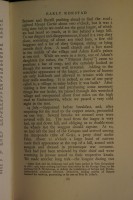 On page 23 the book quotes the following very important reference related to the Griqua settlement at Mount Currie on 22nd July 1867. The source
is the Journal of the Umzimvubu Prospecting Company's Expedition to Nomansland and Amapondoland and the relevant page scanned right:
On page 23 the book quotes the following very important reference related to the Griqua settlement at Mount Currie on 22nd July 1867. The source
is the Journal of the Umzimvubu Prospecting Company's Expedition to Nomansland and Amapondoland and the relevant page scanned right:
"To our disgust and disappointment we found it (the laager at Mount Currie) a very dirty place, consisting of about 200 mudhuts,
a few old waggons, and a lot of dirty Griquas, sitting or lying outside their dens.
A small church and a fort in the middle of the village and Adam Kok's house at one end.
While we were in the store, one of Adam's daughters (or rather the "Princess Royal") came to purchase a bar of soap, and she certainly
looked as though the money was well invested.
Adding to the miserable appearance of the laager a number of houses half built and allowed to remain with their four walls standing.
It is indeed, as one of our party called it, a village in ruins before it was built. After visiting a few stores and purchasing
some necessary things for our larder, we passed through this wretched village and outspanned about four miles on the high road to Grahamstown.."
There are only three known references to the Griqua Mount Currie settlement's makeup - making this a very valued source.
More related history at this link. In 2009 Balson, using Google Earth, rediscovered the foundations of the lost settlement ogf Mt Currie.
The Balson Holdings Family Trust has a first edition hard copy in very good condition.
Critical comment on this work:An interesting compilation of letters, comments and papers by early settlers - a bit limited in its overall view of Natal |
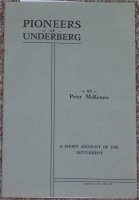 Pioneers of Underberg - Peter McKenzie (1946)
Pioneers of Underberg - Peter McKenzie (1946)
 This extremely rare
first edition pamphlet, just 22 pages long and about A5 in size, records
the early history of the first white settlers in the district of Underberg.
This extremely rare
first edition pamphlet, just 22 pages long and about A5 in size, records
the early history of the first white settlers in the district of Underberg.
Underberg borders Nomansland and several references are made by the author to events taking place there and the impact on the small white community of farmers living in the Underberg region.
This first edition book is extremely rare although there is a later limited edition reprint of 150 copies which records its rarity on its frontpiece:
"[Pat McKenzie] took up farming in the Underberg district in 1892 and died there in 1949, three years after Pioneers of Underberg was published. McKenzie was also the author of a novel The last millionaire and of pamphlets on nationalization of land. Although the Pamphlet Series has thus far released facsimiles of older material, the publishers feel that Pioneers of Underberg is sufficiently scarce as to warrant inclusion in the series. It would appear to be the earliest published history of Underberg district, and all subsequent histories have drawn heavily from it."
The book is similar in content to "On the High Flats of Natal" and "Old Umzimkulu"
The Balson Holdings Family Trust has a copy in very good condition.
Critical comment on this work:A hands on observation by a priest who was well respected in his time |
 Travels in the interior of South Africa - William
J Burchell 1822/24 -
Travels in the interior of South Africa - William
J Burchell 1822/24 -
 Contains frontispiece
portrait of Burchell, plus 18 colour plates by Burchell and numerous b/w
line drawings throughout. Both volumes are in perfect condition. This facsimile
edition is limited to just 1250 copies.
Contains frontispiece
portrait of Burchell, plus 18 colour plates by Burchell and numerous b/w
line drawings throughout. Both volumes are in perfect condition. This facsimile
edition is limited to just 1250 copies.
The original book is extremely rare and even this 1953 reprint by I Schapera of these two volumes cannot be found on the Internet. This set is inscribed by Robin Fryde to Dr Julian Katz who was appointed the first Professor of Child Psychiatry in Australia in 1963. (See image below)
An extract of Burchell's book relating to the state of Klaarwater in 1811 can be seen at this link
Mendelssohn, vol. 1, p. 224, comments on the original publication, "The most valuable and accurate work on South Africa published up to the first quarter of the nineteenth century, and embracing a description of a large part of the Cape Colony and Bechuanaland at this period."
The Balson Holdings Family Trust holds copies of these two reprint books in perfect condition (1953 and 1967 reprints).
Critical comment on this work:A rare reprint of a classic work sought after by book collectors. |
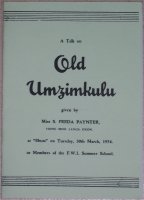 A
talk on Old Umzimkulu - Miss S Freda Paynter (1954)
A
talk on Old Umzimkulu - Miss S Freda Paynter (1954)
 This extremely rare
pamphlet, just 18 pages long and about A5 in size, records the early history
of the first white settlers in the district of Umzimkulu.
This extremely rare
pamphlet, just 18 pages long and about A5 in size, records the early history
of the first white settlers in the district of Umzimkulu.
The book is similar in nature to that by Ken Strachan (below) and Peter McKenzie (above). It discusses the early days of Umzimkulu. Here is an extract:
I want you, in your imagination, to try and conjure up a picture of this district as it was a century and a half ago.
The physical features, of course, were the same - the tawny river, the hills and plains, but there were no roads only tracks; the hills were covered with dense forests and over the plains roamed wild animals - lion, elephant, buffalo and leopard - and there were hippos in the river. Scattered here and there in the bush were little beehive huts, where natives lived in a very primitive state.
Miss Paynter speaks in glowing terms of Madonela, Donald Strachan, and his wonderful humanitarian nature among the natives.
The book is similar in content to "Pioneers of Underberg" and "On the High Flats of Natal"
The Balson Holdings Family Trust has a copy in excellent condition.
Critical comment on this work:A hands on observation by a lady who lived in the area and spoke of her fondest memories. |
 Lightest Africa - F Spencer Chapman (1955)
Lightest Africa - F Spencer Chapman (1955)
The name is a parody of Stanley's earlier work "Darkest Africa". As Chapman explains, I have called this book "Lightest Africa". When Stanley chose the title "Darkest Africa" for the accounts of his marvellous travels, he was thinking of the pygmies in the Ituro Forest and the immense herds of wild elephant and buffaloes in the limitless green savannah. Nowadays the emphasis has been reversed and "Darkest Africa" implies the overcrowding and crime in the slums of Johannesburg's shanty town and the tragic plight of the Cape Coloureds, whereas "Lightest Africa" is concerned with the primitive unspoilt tribes in remote Karamoja, the snows of Kilimanjaro and the wonderful game reserves.
Chapman's travels took him through East Griqualand as he travelled from Cape Town to East Africa.
The Balson Holdings Family Trust has a copy in very good condition.
Critical comment on this work:A hands on observation by a young man travelling through South Africa |
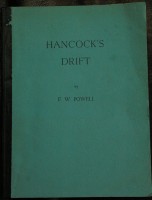 Hancock's Drift - F W Powell (1960)
Hancock's Drift - F W Powell (1960)

This self published 100 page work is printed on A4 paper and extremely rare.
The book is signed by the author (see below) and contains
a fascinating insight into the early pioneering days - covering the Hancock
family before they left England, their trip on the Aurora as part of the 1820
Settler campaign, their location in Grahamstown before settling at Umzimkhulu.
The book covers the exploration and development of the ox wagon route
from Durban to Grahamstown by Thomas Hancock and his final move to Umzimkhulu in the 1860s - at
the time the Griquas were migrating from Philippolis.
The Balson Holdings Family Trust
hold a copy of this book in excellent condition.
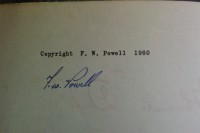 |
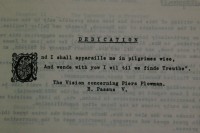 |
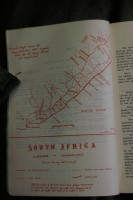 |
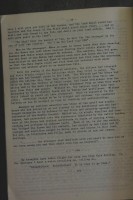 |
|
The author's inscription |
Dedication |
Map of the ox wagon route |
Page out of the book |
Critical comment on this work:A hands on observation by a well-respected leader of the community in East Griqualand. Very valuable insight into the life and times of the people of the region in the late 1800s |
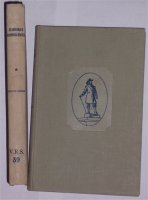 Stanford's Reminiscences - J W MacQuarrie (1962)
Stanford's Reminiscences - J W MacQuarrie (1962)
This two volume book (#39 and #43) produced by the van Riebeeck Society of Cape Town looks at the life of East Griqualand's Resident Magistrate, Sir Walter Stanford, in his own words.
These excellent books cover a long period of history based at Umzimkulu, starting in 1884 going through to the early 1900s. In the book Stanford discusses the disturbances in the region involving the Pondos and other native tribes (including cattle theft), the issues with the Griquas and the last of the bushmen in Nomansland. He also gives fascinating insights into some of the unusual cases brought before the courts, including defamation actions brought against the Kokstad Advertiser as well as the tarring and feathering of an errant white settler. Stanford talks about Donald Strachan's important role with his small army, the Abalandalosi, and his ability to act as a translator from Xhosa into English.
A very readable book which is quite readily available through the Internet.
The Balson Holdings Family Trust has two copies of the two volumes all in excellent condition.
Critical comment on this work:A hands on observation by a well-respected leader of the community in East Griqualand. Very valuable insight into the life and times of the people of the region in the late 1800s |
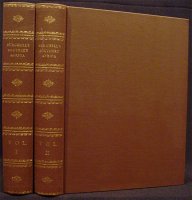 Travels in the interior of South Africa - William
J Burchell 1822/24 - 1967 Reprint
Travels in the interior of South Africa - William
J Burchell 1822/24 - 1967 Reprint
 This is a
limited/numbered reprint, No. 408 of 1000.
This is a
limited/numbered reprint, No. 408 of 1000.
Contains frontispiece portrait of Burchell, plus 18 colour plates by Burchell and numerous b/w line drawings throughout. Fold-out map of the Extra-tropical part of Southern Africa. Both volumes are in perfect condition.
The original book is extremely rare and even the 1967 reprint of these two volumes is worth upwards of US$500. This is the better of the two facsimile reprints of Burchell's work held by the Balson Holdings Family Trust.
An extract of his book relating to the state of Klaarwater in 1812 can be seen at this link
Mendelssohn, vol. 1, p. 224, comments on the original publication, "The most valuable and accurate work on South Africa published up to the first quarter of the nineteenth century, and embracing a description of a large part of the Cape Colony and Bechuanaland at this period."

The drawing of Griquatown by Burchell in 1812 before the Griqua deserted
the settlement in 1813 -
Balson visits
the exact spot
The Balson Holdings Family Trust holds copies of these two reprint books in perfect condition (1953 and 1967 reprints).
Critical comment on this work:A classic work sought after by book collectors. |
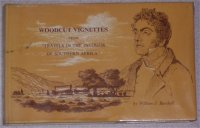 Woodcut Vignettes from "Travel in the interior of South
Africa" -
Woodcut Vignettes from "Travel in the interior of South
Africa" -
William John Burchell (1968)
The original "Travels in the interior of South Africa" by William Burchell is one of the most expensive and rare early works on South Africa.
This small book is a reprint of over 50 woodcut vignettes from this book which contains two images and comments of important relevance to the early history of the Griquas.
The plates number 32 and 34, which appear on pages 350 and 506 of Burchell's original work, give an accurate insight into the life and living conditions of the Griquas at Griquatown just two years before the arrival of Rev John Campbell.
These images of the village's most substantial buildings (shown below) demonstrate that the Griqua people were in no condition to use money - as claimed in the transcripts of Campbell's journals following his first visit to the Griquas in 1813. More at this link.
The Balson Holdings Family trust owns a copy in excellent condition.
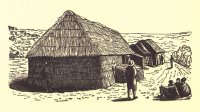 |
|
The Church at Griquatown |
Dam Kok's house and wagon |
Critical comment on this work:These insightful images give us a clear insight into the very rudimentary village lifestyle of the Griqua peoples in the early 1800s |

![]() This rare 320 page hardcopy book
facsimile reprint is entitled "Exhibiting a
Faithful and Correct View of the Manners and Customs of the Inhabitants of the
Cape of Good Hope and Surrounding Country. With a full and comprehensive Account
of the System of Agriculture adopted by the Colonists: Soil, Climate, Natural
Productions, &c. &c. &c., interspersed with observations and
reflections on the STATE OF SLAVERY in the Southern Extremity of the African
Continent. In a series of letters from an English Officer during the Period in
which that Colony was under the protection of the British Government.
Illustrated with Engravings."
This rare 320 page hardcopy book
facsimile reprint is entitled "Exhibiting a
Faithful and Correct View of the Manners and Customs of the Inhabitants of the
Cape of Good Hope and Surrounding Country. With a full and comprehensive Account
of the System of Agriculture adopted by the Colonists: Soil, Climate, Natural
Productions, &c. &c. &c., interspersed with observations and
reflections on the STATE OF SLAVERY in the Southern Extremity of the African
Continent. In a series of letters from an English Officer during the Period in
which that Colony was under the protection of the British Government.
Illustrated with Engravings."
Negro Universities Press, New York, 1969. Reprinted from the rare original 1806 London edition.
An account of the Cape of Good Hope before the Batavian Republic. An anonymous British officer, the writer of this series of 39 letters, was evidently a strong opponent of slavery, and a large part of the work is devoted to both his views on the matter, and a sketch of the various forms of slavery that have existed from ancient times.
Contains ten great full-page reproductions of engravings which appeared in the original. Hardbound in brown cloth with gilt title on spine, in pristine, virtually as-new condition (see scans below). Front and rear hinges slightly darkened in gutter due to darkening of binding glue over time, this is quite minor. No dust jacket (none was issued.)
A valuable reference work.
The Balson Holdings Family Trust holds one copy of this facsimile reprint in very good condition (it also holds the first edition 1806 book).
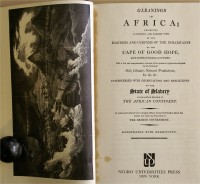 |
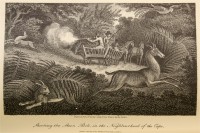 | |
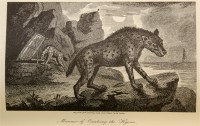 |
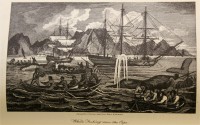 |
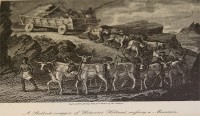 |
Critical comment on this work:Excellent reference book - detailing how poorly the indigenous Hottentot people were treated. |
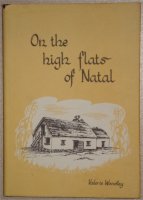 On the high flats of Natal - Valerie Woodley
(1984)
On the high flats of Natal - Valerie Woodley
(1984) 
This 98 book is in near perfect condition with its original jacket. It covers the early history of a small region near Ixopo called High Flats and is limited to just 250 editions - each copy being signed by the author.
The book describes the territory in the 1800s, the first settlers including Donald Strachan and the Kence coins (see below).
The book is similar in content to "Pioneers of Underberg" and "Old Umzimkulu" and is very rarely seen on any auctions.
Some of the lovely plates from the book are displayed below.
The Balson Holdings Family trust owns number 208 of 250 in excellent condition.
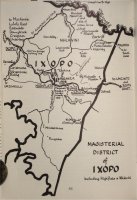 |
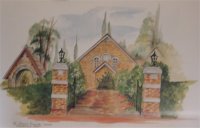 |
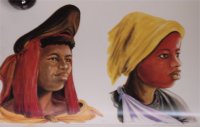 |
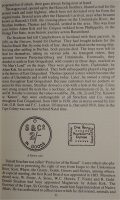 |
The Ixopo District |
St Johns Church |
Zulu Maidens |
Critical comment on this work:These insightful work give us a clear insight into the early history of this region. |
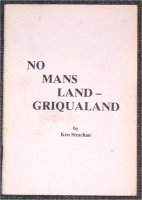 No Man's Land - Griqualand - Ken Strachan (1985)
No Man's Land - Griqualand - Ken Strachan (1985)
 This self-published
work is an extraordinarily rare work by Ken Strachan, Donald Strachan's grandson.
This self-published
work is an extraordinarily rare work by Ken Strachan, Donald Strachan's grandson.
Ken was the last Strachan to run the empire built by Donald and in this small 20 page soft cover book he recounts his memories and the stories he was told about the early days (1800s) of Nomansland.
The book outlines the early history of key white settlers in Nomansland including the Hulleys, Hancocks, Strachans, Callaways and Buttons.It covers the tragic trek by the Griquas from Phillipolis over the Ongeluksnek (Drakensberg) and into Nomansland.
The small book also covers the Griqua "rebellion" and the Gun War.
The Balson Holdings Family trust owns a copy signed by Ken Strachan.
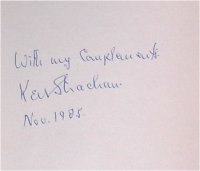 |
|
Signed by Ken Strachan |
Book has several changes hand written by author |
Critical comment on this work:Ken Strachan was the man who opened up the gates to this on-line work on the Strachan and Co tokens. A very humble man but one who spells out, factually, the early times of Nomansland under the influence of the "white" man. |
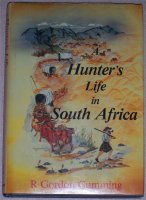 A Hunter's Life in South Africa - R Gordon Cumming
1986 Reprint
A Hunter's Life in South Africa - R Gordon Cumming
1986 Reprint
This diary catalogues Cumming's adventures in 1844 - 1845 as he went hunting through Central South Africa. There is a chapter (7) dedicated to the Griqua at Philippolis and Rhama.
Cumming is less than complimentary about the Griquas that he met suggesting on page 91, They are, without exception, of an indolent disposition, and averse to hard work of any description; much of their time is spent in hunting, and large parties annually leave their homes and proceed with their waggons, oxen and horses on hunting expeditions into the far interior, absenting themselves for three to four months at a time. They are remarkable for their disregard of the truth, a weakness which I regret to state I found very prevalent in South Africa; they are also great beggars, generally commencing by soliciting "trexels", a trexel being a pound of tea or coffee. He is also harsh on the boers referring to them as "drunks".
Perhaps the greatest value of this book is his lengthy and detailed descriptions including that of grasslands literally swarming with springbok, kudu, gemsbok and wildebeest. His book is blamed as being the trigger for a raft of white hunters who followed - wanting to experience the awesome sight of massive herds of buck. He also describes in great detail the structure and make up of the typical "beehive" shaped Griqua house and its portability...
Interestingly Cumming still refers to the "Griquas" at Philippolis as being called "Bastards" under Adam Kok while he referred to them as being known as Griquas under Waterboer at Griquatown. He is very clear on this - stating that they were once united but had now split into the two groups and named accordingly.
Cumming met and stayed with the famous missionaries Robert Moffat (at Kuruman) and Dr David Livingstone (at Mabotsa) - Livingstone had earlier married Moffat's eldest daughter in 1844.
The reprint of this book can be acquired quite easily through the Internet - the rare early edition is displayed at this link.
The Balson Holdings Family Trust holds a copy of this book.
Critical comment on this work:An easy to read and well written book which gives an interesting insight into the life and adventures of Gordon Cumming who had an Eton education. |
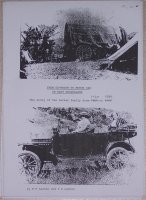 From
Ox-Wagon to Motor Car in East Griqualand - Robert Percy Larkan
(1986)
From
Ox-Wagon to Motor Car in East Griqualand - Robert Percy Larkan
(1986)
 This is an
extraordinarily rare copy of an original manuscript by the late Robert Percy
Larkan completed through the assistance of his son P A Larkan after he went
blind.
This is an
extraordinarily rare copy of an original manuscript by the late Robert Percy
Larkan completed through the assistance of his son P A Larkan after he went
blind.
The unpublished work resulted from a meeting that Scott Balson had with Percy Larkan in Durban in 1977. At Scott's prompting Percy Larkan set about recording his family's past and more importantly their time in East Griqualand.
The book has an interesting slant on the impact of motor vehicles in East Griqualand but it is Percy's first hand anecdotes of those early days that make this 50 page manuscript so invaluable. The trials of the small ferry that ran to one of their stores from the other side of the Umzimkulu, gossip on who ran what trading store in the early 1900s and why. Land ownership, supplying milk at Thorninghurst - and, most important of all, the important role of the F C Larkan trade tokens - named after his mother, Frances Charlotte Larkan.
The Balson Holdings Family trust owns a copy courtesy of the Kokstad Museum.
Critical comment on this work:While this manuscript would require a lot of work before it could be published it is the anecdotes and previously unpublished insights that make Percy Larkan's work so valuable. |
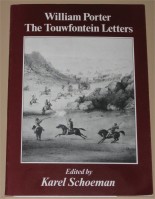 The Touwfontein Letters - William Porter (1992)
The Touwfontein Letters - William Porter (1992)The Touwfontein letters were written by William Porter a prominent settler who became the Attorney General of the Cape Colony.
These letters cover the early conflict between the Griqua and the migrating Boers in the 1830s and 40s.
Porter has little good to say about the Griqua. In fact he describes the Griqua women at Philippolis thus, "They were an antidote to every amorous emotion" (pp48) and complains about a meeting in a small room with Adam Kok and Hendrik Hendriks in which there was not enough fresh air to disperse the pungent smell.
Of particular interest is the timing of Porter's letters at Colesberg - during the Battle of Swartkoppies in 1845 when the British came to the aid of the Griqua and defeated the recalcitrant Boers (see the images below).
The Balson Holdings Family trust owns a copy in excellent condition.
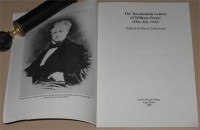 |
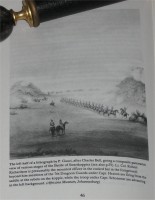 |
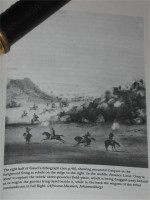 |
Critical comment on this work:Fascinating insight into the drama taking place between the Griqua and the Boers in the late 1830s - 40s. |
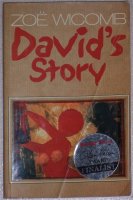 David's
Story - Zoe Wicomb (2000)
David's
Story - Zoe Wicomb (2000)
David Dirkse has to tell his story to unravel the complex web of histories which have woven him into the moment of liberation and transition in South Africa. He needs a woman to hear him out because he has become confused not only about the meaning and import of the freedom struggle for him as a coloured of Griqua descent, but also about what women mean to him.
Davids Story brings to life the history of the aboriginal Griqua people in a profound multi-layered reflection on the meanings of freedom and bondage in the South African world. It is also a story of love forged in the heat of political struggle and then lost in the ambiguous and dangerous cross-currents of the transitional situation.
The Balson Holdings Family Trust has a copy of this book.
Critical comment on this work:An interesting novel about post Apartheid South Africa and touching on the Griqua history - especially conflicting views on the role of AAS Le Fleur |
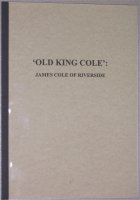 "Old
King Cole" - James Cole of Riverside - Milner Snell (2006)
"Old
King Cole" - James Cole of Riverside - Milner Snell (2006)
 This is a rare and
fascinating insight into the life of one of East Griqualand's most colourful
and wealthiest characters.
This is a rare and
fascinating insight into the life of one of East Griqualand's most colourful
and wealthiest characters.
The author, Milner Snell, is the Chair of the Kokstad Museum and has done extensive research which led up to this biography James Cole. Milner is also related to James Cole.
A summary of James Cole's amazing antics can be seen at this link.
See also Milner Snell's excellent book on Strachan and Company traders in this region.
The Balson Holdings Family trust owns a copy in excellent condition.
Critical comment on this work:An invaluable work with an enormous amount of information on this man |
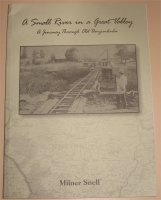 A small river in a great valley, a journey through old
Umzimkulu - Milner Snell (2007)
A small river in a great valley, a journey through old
Umzimkulu - Milner Snell (2007)
 This is a rare and
fascinating insight into the early settlers in the Umzimkulu Valley.
This is a rare and
fascinating insight into the early settlers in the Umzimkulu Valley.
The author, Milner Snell, is the Chair of the Kokstad Museum and has done extensive research which led up to this excellent work on the early traders, Griquas and farmers who resided in the "great valley".
The book has numerous old photographs and fascinating stories and glimpses into the life and times of the early settlers in this region.
See also Milner Snell's excellent book on Strachan and Company traders in this region and the listing above on James Cole.
The Balson Holdings Family trust owns a copy in excellent condition.
Critical comment on this work:An invaluable work with an enormous amount of information on the earliest recorded times of the Umzimkulu valley |